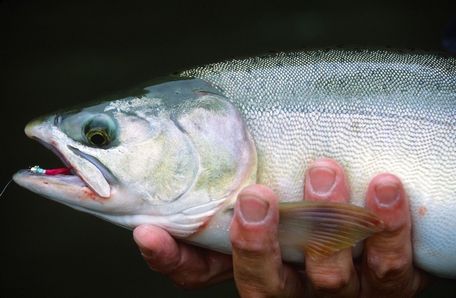By Mike Benbow, The Herald

Pinks like to travel close to shore, so fishing for pink salmon is a great family sport.
They’re expecting 6.2 million pink salmon to enter Puget Sound this year.
If you or a member of your family have always wanted to catch a salmon, now is your best chance.
The sheer numbers of pinks will up your odds of success either in the Sound or in the local rivers.
“A bumper crop of pink salmon always generates a huge response from anglers,” said John Long, statewide salmon manager for the Washington Department of Fish and Wildlife. “You can catch them from a boat, you can catch them from the shore and you can catch them throughout most of Puget Sound. It’s a great fishery for kids and whole families.”
If you’d like to make catching a pink a family project this year, here’s some information that might help. Fishing should be good now and for the next few weeks.
Where to go
More than any other salmon, pinks like to travel close to shore while heading to their home rivers, so fishing from the beach is an effective way to catch them in salt water, especially if you don’t have a boat.
Whether in a boat, on a beach, or on a river bank, look for pinks jumping and rolling as a sign of where to cast your lure or fly.
Salt water with boat: Humpy Hollow (south of Mukilteo) or Kayak Point (south of Stanwood).
Beaches: Bush Point (Whidbey Island), Picnic Point (Edmonds), Kayak Point (south of Stanwood).
Rivers: Stillaguamish, Snohomish, Skykomish. Tip: the fish are in better eating condition if you fish closer to salt water.
The Snohomish/Skykomish system is already open for pink fishing. The North Fork of the Stillaguamish is closed to salmon fishing, and the main stem of the Stillaguamish doesn’t open for pinks until Sept. 1.
Keeping pink salmon
Pinks deteriorate quickly, but they are good table fare if cared for properly.
After catching a pink, remove the gills and let the blood drain out of the fish. You can filet them later. Put on ice right away. Eat the fish in the next day or so.
Cooking pinks
Pinks are an oily fish, so they work well on the smoker. But they also can be tasty on the grill.
Fillet the salmon and add some lemon juice, fresh cracked pepper and some butter.
Cook on the grill at about 375 degrees for 18 to 20 minutes. Much of the oil will drip off the salmon onto the grill, adding a smoky taste.
Serve with lemon basil aioli: In a small bowl mix 1/4 cup of mayonnaise, 1 tablespoon of chopped fresh basil, 1 1/2 teaspoons of grated lemon zest, 2 teaspoons of fresh lemon juice, a small clove of minced garlic, and 1/4 teaspoon of kosher salt.
Pink marabou jig
I consider pink marabou jigs to be the most effective lure for pinks in both salt and fresh water. You fish them by jigging the rod up and down while reeling in your line, creating an erratic action that is often irresistible to fish.
You can buy them at most sporting goods stores, including John’s Sporting Goods, 1913 Broadway, Everett; Ted’s Sports Center, 15526 Highway 99, Lynnwood; and Cabelas, 9810 Quil Ceda Boulevard, Tulalip.
Jigs are also easy to make and the materials are available at the same locations. Here’s how:
Buy: 1/4-ounce lead-headed jigs, hot pink marabou feathers, hot pink thread, a thread bobbin, Sally Hansen’s Hard as Nails clear fingernail polish (available at any drug store).
You will also need a pair of sharp scissors and some sort of tying vise. Fly-tying vises are expensive, so you can use a regular woodworking vise in your workshop, pliers or vise grips if you’re just going to make a few.
1. Attach jig to vise.
2. Attach thread to jig collar by wrapping it over itself a few times.
3. Stroke tip of entire marabou feather and cut so it extends from the head of the jig to about 3/4 of an inch past bend of hook.
4. Tie cut end in at jig collar with several wraps of thread.
5. Repeat with two more feathers to cover entire collar of jig.
6. Wrap thread repeatedly over cut edge of feathers to produce a neat collar below jig head. Tie off thread with three half hitches and cut end with scissors.
7. Coat thread with nail polish and let dry.
Pink gear
Rods: Use a medium weight spinning rod or a 5- to – weight fly rod, either should be about 9 feet long.
Line: Line or leader material should be 8- to 12-pound test.
Lures: Pink Buzz Bombs, 2.5 inches long, or Rotators, or a 1/4-ounce pink marabou jig. Fly fishers can use pink clousers in the Sound and a pink woolley bugger in the river.
By the numbers
2 The lifespan in years of a pink salmon, which spawns in most Washington rivers in odd-numbered years.
3-5 The weight of a pink salmon in pounds. Pinks are the smallest of the five species of Pacific salmon.
18-24 The average length of pinks in inches.
409,700 The number of adult pinks expected to spawn in the Stillaguamish River this year based on a count of the young fry that left the river two years ago.
988,621 The number of pinks expected this year in the Snohomish River and its tributaries.
